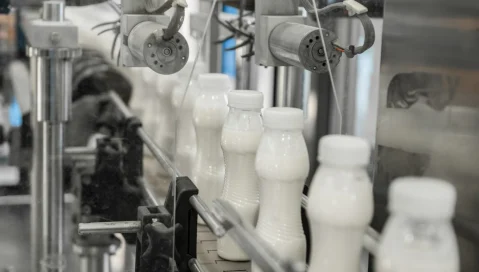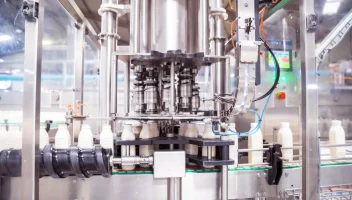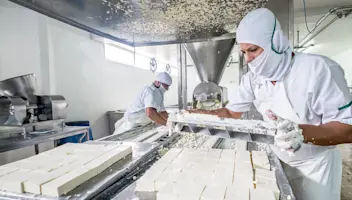Responding to the Popularity of Plant-Based and Lab-Grown Dairy
Responding to the Popularity of Plant-Based and Lab-Grown Dairy
Responding to the Popularity of Plant-Based and Lab-Grown Dairy
13 Sep 2021
John McCurdy
Recent years have seen huge growth in the popularity of plant-based or lab-grown alternatives to traditional products. Even with the roaring success of meat alternatives, nowhere has this trend been more pronounced than in the dairy alternative market. It is thought that plant-based milk alone now accounts for over 35% of the U.S. plant-based food market.
The shift toward dairy alternatives has been so pronounced that some industry experts believe it will one day account for the majority of all dairy sales—not least plant-based milk, which is already a $10 billion dollar a year market.
With the success of plant-based dairy clear to see, and with lab-based dairy set to make a genuine breakthrough, traditional dairy producers need to be able to respond. Let’s take a look at the drivers behind the growing popularity of dairy alternatives and explore how dairy companies that haven’t already incorporated them into their product range can capture a share of the market.
Plant-Based Dairy vs. Lab-Made Dairy: What’s the Difference?
Dairy alternatives can be categorized into two distinct categories. Namely, they are either plant-based or lab-made, and both have their nuances and challenges to navigate.
Plant-Based Dairy
Plant-based dairy has been produced for centuries, but only became widespread in Western countries in the 1970s with soy milk emerging as a useful replacement for lactose-intolerant people. And while the popularity of soy milk has declined, in part due to growing awareness of how its production promotes deforestation, other types of plant-based dairy have emerged from obscurity to become household favorites.
Non-soy plant-based milks are now the fastest growing category in the dairy market, seeing a 16% increase from 2020 to 2021. Some of the most popular plant-based milks (and products like ice cream derived from milk) are produced from:
Almond
Oat
Coconut
Hemp
Rice
Embracing plant-based dairy is something that more and more traditional dairy producers are looking to do. The great advantage is that such a transition can help to future-proof a dairy business. Plant-based dairy is a growing market in which producers have more power to set fair prices for their products. By contrast, consumption of milk in the UK has dropped by 50% since the 1970s (with this decline mirrored in other regions), while producers are frequently underpaid by retailers.
The major downside of producing plant-based milk is the difference in the production processes and adjusting for those differences. For instance, moving away from animal-based agriculture towards farming oats or almonds is a big departure for most dairy producers, and that’s without taking into account the other ingredients required to make plant-based products. However, with the right help and the right technology, it is possible for producers to make the jump successfully.
Lab-Made Dairy
Lab-produced dairy, on the other hand, is the attempt to grow “real” dairy products without the use of any animals. A process known as “precision fermentation” uses genetically engineered microorganisms to create real animal products, such as milk. Greater strides have already been made for lab-grown meat, but lab-made dairy is not far behind.
The goal of lab-produced dairy is to replicate the taste and characteristics of conventional dairy. This could one day win over millions of non-vegan consumers who have historically been put off by the taste profile of dairy alternatives.
With lab-made dairy still in its infancy, it is simply too expensive for most dairy businesses to take it up just yet, but one day soon the cost of production (and therefore the cost to the consumer) will come down, making it a viable option for more dairy producers. Getting involved in this market early could prove lucrative in the long term, given the taste profile of lab-made dairy products is closer animal-produced dairy, offering a more “authentic” product for discerning consumers.
Why Is Alternative Dairy Growing in Popularity?
The technologies used to manufacture plant-based dairy products have been in existence for decades, but their popularity has exploded over recent years. This trend shows no sign of slowing down, with the industry set to experience an annual growth rate of 11% between 2020-2027.
It’s clear there are some significant drivers behind the growing popularity of plant-based dairy. These look likely to benefit lab-grown dairy too in the coming years as the technology is improved and the cost of production comes down.
Sustainability concerns. For many consumers, sustainability is now one of the key factors in their decision-making when buying food products. Shoppers are increasingly seeing dairy alternatives as a way of eschewing the environmental impact of dairy farming.
Health. 39% of people that consume plant-based milks do so because they perceive them as healthier options. Dairy alternatives tend to be lower-calorie and lower-carb, however in reality they often lack the same levels of nutrition (calcium, potassium, etc.). Increasing the nutritional value of dairy alternatives is one of the major challenges this industry faces.
Shelf stability. Unlike conventional milk, most plant-based milk products can be stored at room temperature and last longer once opened. The shelf stability of plant-based milk is becoming more attractive, especially for consumers living alone.
Animal welfare. One of the biggest barriers to people embracing a vegan or flexitarian lifestyle is their unwillingness to give up dairy. However, with dairy alternatives improving their flavor profiles, more consumers are seeing them as viable replacements. Lab-grown milk could prove especially popular for this type of consumer in the coming years.
Cafe culture. Many consumers have been introduced to milk alternatives through their experiences buying coffee from cafes. The biggest coffee shop chains have been offering plant-based milk alternatives for many years, prompting shoppers to adopt them as part of their home routines too.
How Can Dairy Manufacturers Capitalize?
The dairy industry is already struggling in many markets—around 3,000 dairy farms are closing every year in the U.S. However, the increasing popularity of dairy alternatives presents traditional dairy producers with a real opportunity, as the plant-based market is set to continue growing quickly. It’s clear that many traditional dairy producers could benefit from diversification of their product range or even pivoting entirely to plant-based production, as some have already done.
Indeed, some dairy businesses have already begun the transition towards plant-based dairy products, recognizing a need to get ahead of the curve. Making this jump is, however, a major undertaking. Dairy farms are often family businesses, where expertise has been handed down over generations—moving toward a completely different kind of agriculture will be a step into the unknown for most.
As governments recognize the need for less carbon-intensive forms of dairy production, subsidies and training will help producers make a smooth transition. For most businesses, this will not involve the wholesale replacement of their conventional dairy production, but obtaining a foothold in the plant-based market will be vital for scaling up in this area in future.
An advantage of plant-based dairy is that its fundamental ingredients can be grown in most regions of the world. While almonds and coconuts are the preserve of warmer countries, oats can be produced in cooler climates. This makes it eminently possible that plant-based dairy can be produced on small, medium and large scales.
For producers looking to break into the plant-based market, technology will be a valuable ally. A dairy-specific enterprise resource planning (ERP) solution makes it easier to diversify production and to adjust to new sectors quickly and successfully. Some important features include:
Recipe management modules help businesses develop new plant-based recipes, finding the most cost-effective solutions quicker
Bi-directional ingredient tracking and allergen management facilitates adjusting to the production of multiple lines
Collaborative forecasting and planning allows an organization to schedule multiple production lines across different product types more effectively
Supply chain management helps producers adapt to and better manage new supply chains
Aptean's dairy ERP can help your dairy business adapt to the world of plant-based dairy production quicker, ensuring you’re prepared for the future landscape of the industry. To learn more about how Aptean can help your dairy business, contact our team of dairy industry experts, today.
Related Content





Ready for industry-specific solutions that unlock results?
Our specialised dairy ERP system enables organisational improvement that transforms your business.



